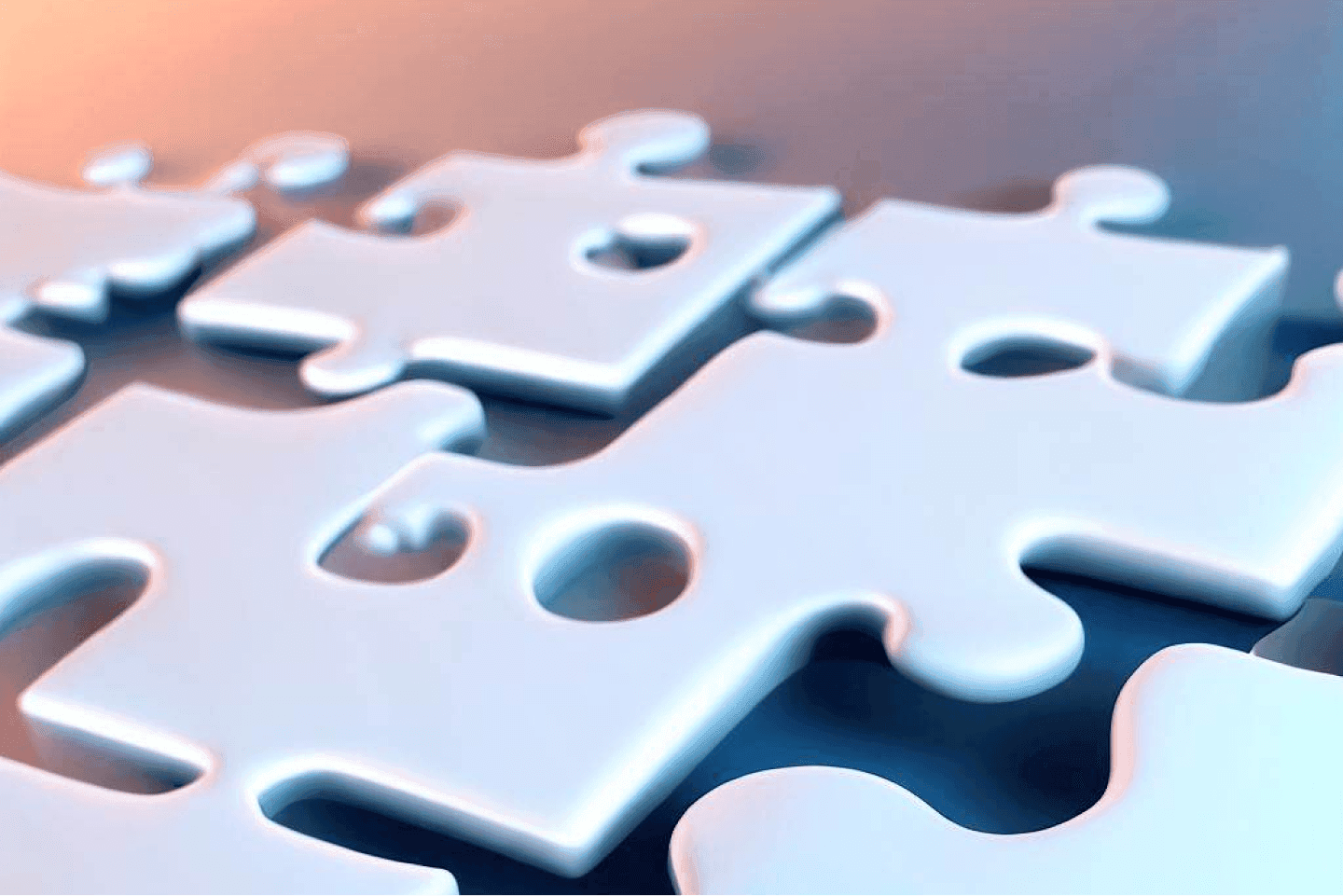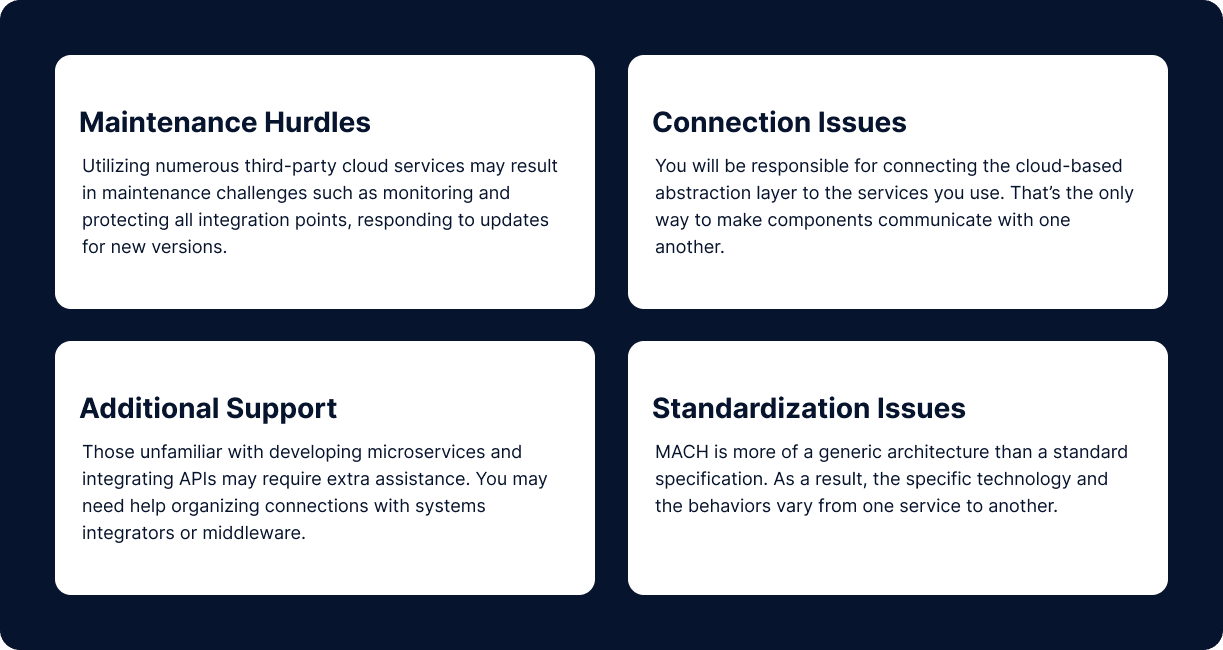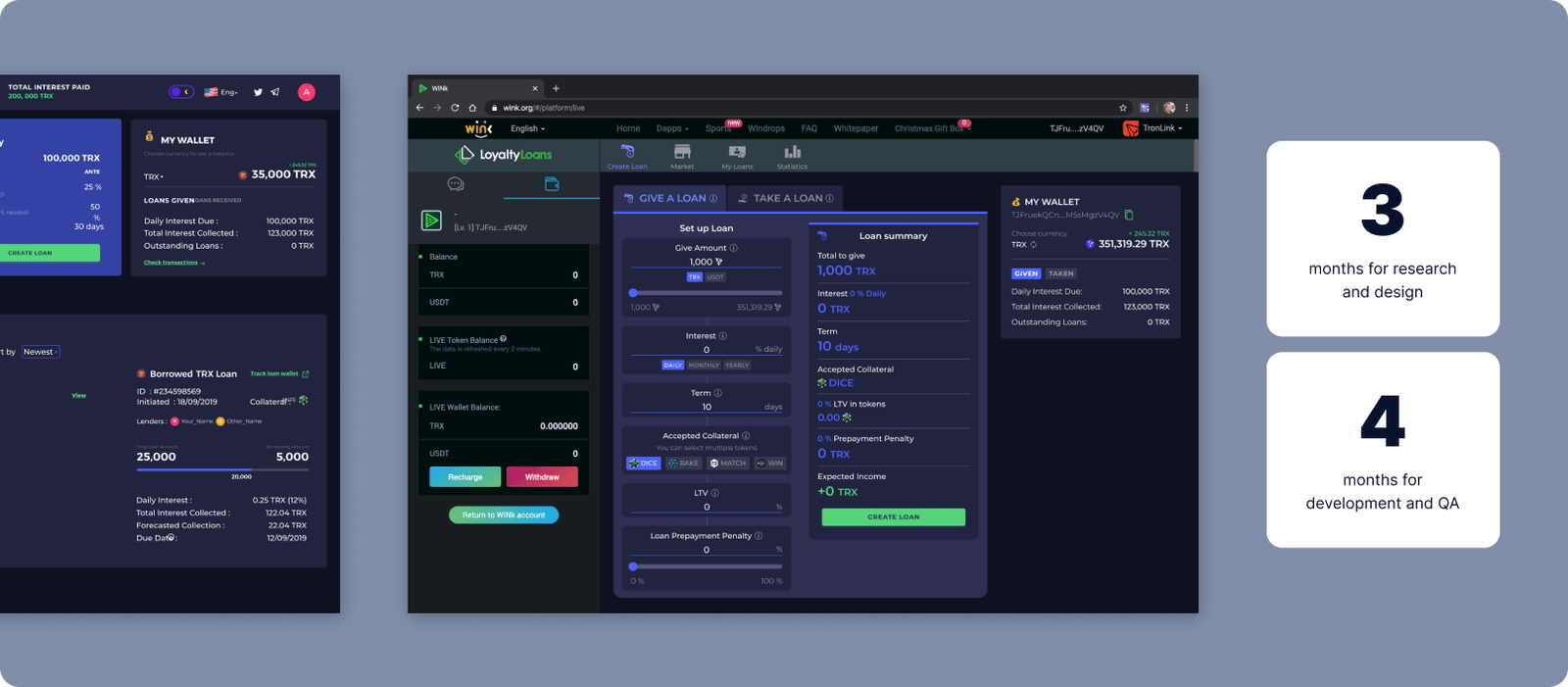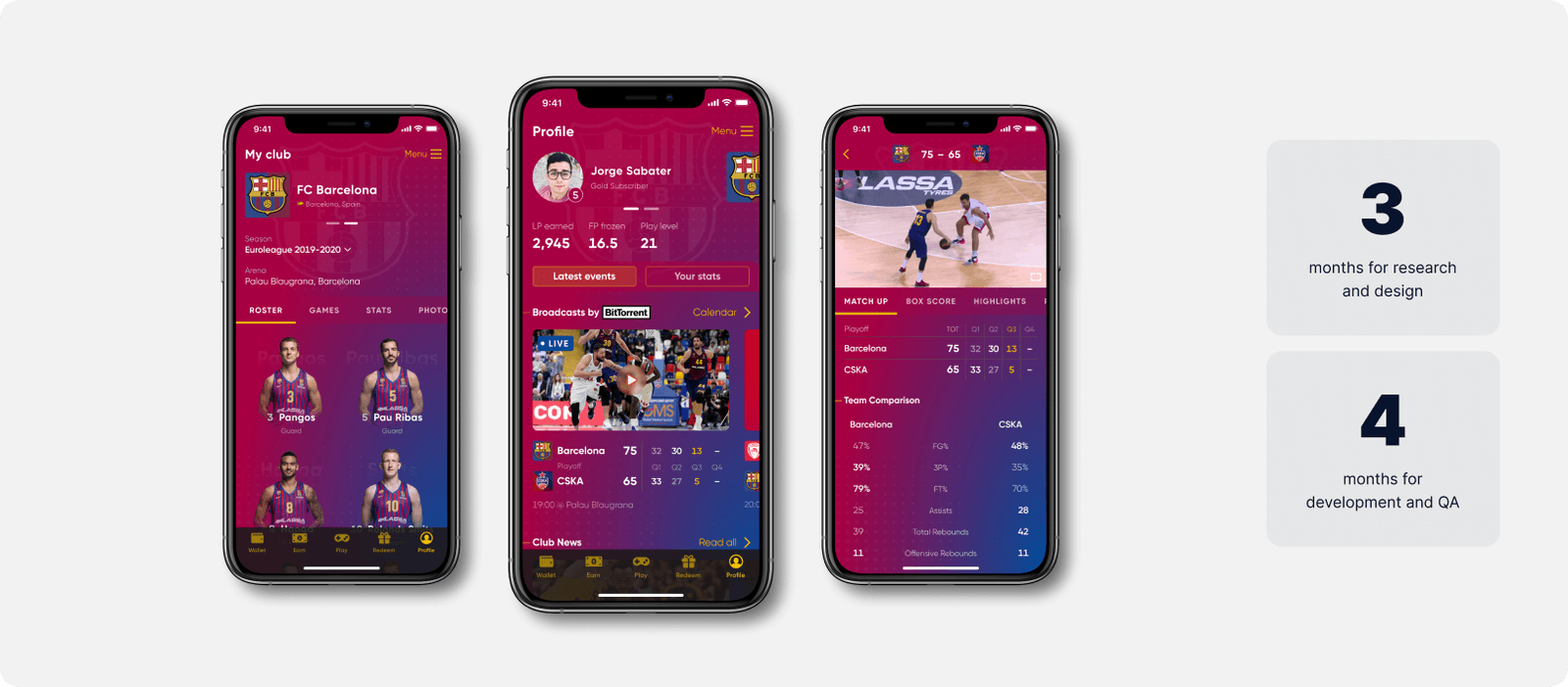
June 21, 2023
MACH Architecture: Ultimate Guide
MACH architecture revolutionizes how businesses develop, distribute, and maintain software. It offers numerous benefits, including scalability, flexibility, excellent performance, increased dependability, improved customer experience, and quicker time to value. Thanks to the MACH approach, enterprises select among the best tools available. Moreover, they maintain a structure that makes it simple to add, modify, or remove those tools in the future.
This article defines MACH, explaining its origins, principles, benefits, and drawbacks. It also provides examples and use cases of MACH architecture. Finally, we will compare it to traditional architecture and evaluate MACH technologies based on Artkai's expertise in end-to-end product delivery and enterprise application development.
What Is MACH Architecture?
MACH is an acronym for Microservices, API-first, Cloud-native, and Headless. It is a collection of concepts and patterns specifying the core building elements of a fresh, pluggable, scalable architecture for developing backend services and cutting-edge user experiences.
The MACH architecture-aligned microservices solution comprises separate parts that interact through a straightforward interface utilizing simple APIs. Each service performs a specific function designed with business capabilities in mind.
The Origins of MACH: How It All Began?
MACH was created when eCommerce businesses realized their monolith systems couldn't meet the growing demands of digital clients. In particular, enterprises had to deal with increased legal data limits, UX requirements, the need for faster and more effective marketing campaigns, omnichannel sales, and more. As a result, a new strategy for developing IT systems became necessary.
Challenges Posed by Monolith Legacy Systems
Enterprises often need to manage the challenges of monolithic systems because of the debt imposed by outdated technology. The thing is that all components of legacy monolithic systems are intricately linked. Therefore, switching to contemporary JS frameworks that improve web performance was risky.
It took a lot of work to change the UI and incorporate UX-focused functionality. Monolithic systems require a lot of time-consuming labor during updates. And since the tightly interconnected systems could collapse, managers tried to avoid them.
MACH Alliance
Businesses started looking for more flexible, customer-focused, agile, and future-proof strategies. And that's when the MACH approach came into play. In 2020, Contentstack, EPAM Systems, and Valtech established MACH Alliance. It’s a non-profit company offering eCommerce companies invaluable knowledge and insights into contemporary technologies and their effects on customer experience.
Defining MACH principles
The MACH principles are centered on composability, enabling you to shape the entire IT ecosystem to correspond to particular business goals. Now, let’s review each component separately to evaluate the advantages and disadvantages of this approach.

M - Microservices
A cloud-native architectural pattern – microservices – organizes an application as a group of services based on particular business or technical capabilities. Usually, a small internal development team works independently to create, test, and implement their capabilities.
Also, independent companies that offer SaaS solutions may hold microservices as a self-contained system (SCS). Developers connect it to an already-existing business solution. Various microservices that make up the solutions are loosely coupled and weakly related to one another. Thus, changes to one service may not impact other system components.
A business or developer doesn’t depend on a particular vendor or technology. That’s because one can substitute services in a hardly linked system with other in-house or outside implementations offering the same services and capabilities.
The Single Responsibility Principle, a guideline for software development, emphasizes that each service in a system should be in charge of a single business or technical concern. Besides, adopting a microservices architecture has many additional benefits. For instance, development teams can produce massive apps quickly and repeatedly. Meanwhile, firms get best-in-class SaaS solutions without dependence on a single vendor.
A - API-first
The API-first approach enables the interaction of two or more systems. Here, APIs are the "first-class citizens." In other words, entities supporting all functions are generally available to other entities. They expose all business functionality through a clear set of contracts. The defined contracts are the entry point to all service business activity. Thus, API-first is strongly related to microservices.
These contracts frequently adhere to API description languages like Open API. They facilitate a robust design and communication between technical and non-technical stakeholders. With this method, companies establish APIs for all devices and platforms supporting all app types in a multi-channel environment.
C - Cloud-native SaaS
Cloud-Native is a cutting-edge method for creating, designing, and running software applications that fully utilize the cloud computing concept. This paradigm uses various contemporary software development techniques. It includes agile methodologies, DevOps, continuous integration and delivery, microservices, and containers. As a result, you get a set of adaptable, scalable, and robust apps.
H - Headless
Headless systems are API-First services supporting application development with a completely separate user interface and backend. Headless systems make their content available via RESTful or GraphQL APIs. You may use them for different services instead of providing a conventional user interface (presentation layer).
Pros and Cons of MACH
MACH integrates several development patterns in the software industry. And while cloud-first is rising, digital apps are becoming more modular. That’s where headless models help with customization. So let's evaluate the most significant advantages and disadvantages of MACH architecture.
What Are the Benefits of MACH Architecture For Business?
Here are the most compelling advantages a business may gain with MACH architecture.
Scalability
Scalable software architecture is one of the primary MACH architecture goals. Streamlined adaptability makes this approach one of its most critical advantages for organizations with shifting needs. For instance, you can scale up MACH technologies to handle the increased load when your business expands.
Composability and Flexibility
The MACH architecture is also highly flexible. Therefore, it’s simple to adapt using best-in-class solutions to meet a company's unique requirements. Due to their adaptability, MACH solutions are ideal for businesses that react quickly to external environment changes. The MACH technology stack offers numerous scalable and adaptable corporate technologies, making it a preferred option for many enterprises.
Future-Proof Technologies
The need for quicker and more efficient data and content processing emerges as the world goes digital. MACH ecosystem technologies cover this need, offering a scalable and adaptable architecture suitable for shifting requirements.
The MACH technology stack is also future-proof. Thus, businesses can utilize it for many years without getting outdated. That’s because of its modular design allowing you to add new components as needed. Therefore, with MACH-first software, companies ensure their purchase will pay off in the long run.
More Rapid Time to Market
With microservices-based MACH architecture, businesses create and deploy applications more swiftly. MACH shortens the time to introduce new features and capabilities to the market. How? It divides applications into discrete, independent services one can create and deliver independently.
Additionally, since MACH services are loosely connected, they are easier to change and update. It lowers the risk of errors and facilitates the rapid and effective rollout of new features and capabilities. As a result, MACH provides a faster time to market, greater agility, and higher overall software quality.
What Are the Drawbacks of MACH Architecture?
Now, it’s time to look at the potential pitfalls you may encounter when turning to MACH architecture.

Examples of MACH Architecture
Below, you will find several enterprises that already benefit from MACH architecture.
eBay
Since 1995, the US-based international retailer eBay (AuctionWeb at that time) has relied on monolithic applications. The store started migrating to the MACH architecture because the monolithic software development restrictions limited their business expansion.
Now, the store can oversee over a thousand microservices, many created with various programming languages thanks to MACH architecture. Each of these services has a separate independent development team. As a result, it reduces time to market for new features and updates and increases user experience standards across all organizational domains.
Shopify
Shopify is a cloud-based e-commerce platform that leverages a Headless architecture. Therefore, developers design unique storefronts and shopping experiences. Shopify is also API-first, so it’s easier for developers to interact with other platforms and services.
But how does it work, exactly? All in all, the Shopify system comprises individual services that are exceptionally efficient for one task instead of committing to a platform that handles everything. Suppose one of the services isn't working correctly. In that case, it’s possible to choose another provider, integrate their API into the codebase, and keep serving the customers' needs.
Promod
Another company that has depended heavily on monolithic architecture is Promod – the French women's clothes retailer. Promod realized that old technology could no longer support its expanding business requirements when 60% of sales went online, accounting for 8% of its overall revenue.
Today, Promod handles a sophisticated ecosystem of microservices and APIs instead of the old monolithic system. It ensures a better mobile shopping experience, offering scalability and flexibility. The company also highlights how robust and workload-resistant its new MACH-based commerce infrastructure is.
Monolith Architecture vs. MACH Architecture
Digital experience platforms help create, manage, and organize customer expectations. Monolith architectures, on the other hand, have significant shortcomings in adapting to changing business requirements.

The issue is that most monolithic architectures need more flexibility and features to meet increasing business functionality demands. As a result, companies aiming to maximize their investments in the digital experience should consider MACH architecture.
| MACH Architecture | Monolith Architecture | |
| Scalability | MACH easily adapts to the organization's changing needs. It facilitates seamless scaling. | Monolith architecture is challenging to scale. Any changes require a complete architecture redesign. |
| Readiness for the Future | Businesses can select the provider that fits their needs without using a particular platform. Besides, it allows for new features as they become available without redesigning the app’s architecture. | Modifying one component may disrupt the entire application since all pieces are closely connected. As a result, it’s challenging and expensive to modify monolithic architecture, add features, and address issues. |
| Flexibility | You can quickly adapt using best-in-class technologies to meet an organization's needs. | A monolith is substantial, so a standalone codebase is difficult to separate and modify. Therefore, enterprises struggle to update the architecture. |
| Composability | MACH streamlines adding and removing functionality as needed. It segments applications into small, independent modules. | Monolith functions as a single unit that is challenging to decompose. |
| Time to Market | MACH is suitable for Agile and iterative development. Thus, businesses respond to market changes and introduce new applications more swiftly. | It’s pretty challenging to implement and manage applications with monolith architecture. It requires specific infrastructure and knowledge, driving up prices and increasing time to market. |
How to Assess MACH Technologies and Architecture
MACH architecture offers numerous advantages making it a desirable choice for enterprises. Perhaps, the most critical one is its scalability. A business can add new applications seamlessly without completely reconfiguring the system. As a result, organizations adapt deployment to their requirements using a highly flexible design.
Businesses should consider their unique demands and needs when assessing the MACH architecture. To evaluate a potential MACH tool, answer the following questions first:
- Can you gradually add and replace services?
- Can you add or replace systems and services independently?
- Does it use APIs from the ground up, or did you add an API later?
- Is technical documentation with the platform’s resources and capabilities easy to access?
- Is the cloud infrastructure scalability unlimited?
- Do updates and upgrades with continuous delivery occur without significant issues?
- Can you design and implement the user experience freely and flexibly?
Thanks to MACH architecture, businesses boost their digital capabilities and advance. Thus, it may benefit any organization that strives to stay on top of emerging trends.
Is MACH Architecture Altering Digital Customer Experience?
MACH is an innovative approach to improving the digital customer experience. It’s gaining acceptance among businesses and companies representing various industries. In contrast to conventional monolithic designs, MACH breaks down each user experience element into a discrete microservice. It facilitates the exploitation of all available features. So with its help, companies alter the consumer experience without reloading the system completely.
Additionally, MACH is more suitable for firms that expand swiftly. It offers more flexibility, capabilities, and scalability than monolithic designs. Many claim it’s the future of the digital customer experience, and some of the largest corporations have already embraced it. So MACH architecture's rapid transformation into the new digital consumer experience benchmark is unsurprising.
How to Build Products Using MACH: Artkai Case Studies
Artkai is a customer-centric digital product development agency with profound expertise in building stellar enterprise applications. Your enterprise software development process will be hassle-free, thanks to Artkai professionals in design and development. Your organization will have a distinct competitive advantage thanks to our robust and scalable business-level solutions.
Here are several cases when Artkai experts implemented MACH architecture principles to build successful future-proof digital solutions.
SaaS Platform for Digital Advertising
Our client had an established track record in digital advertising. Their idea was to create a tool that would fundamentally change the market. Despite the popularity and online advertising development, they still needed an aggregation service to streamline the procedure. The client asked the Artkai team to build a SaaS platform for digital advertising, which could also monitor money withdrawals and facilitate document movement.
We chose a microservice architecture since it ensures efficient development and streamlined maintenance. Moreover, we could create microservices concurrently and independently of one another. The only restriction was selecting an architecture of data-centric microservices using a single shared database. Each of them, however, still had its own unique set of entities.
The product had a soft launch involving end users to ensure all the connected services functioned correctly. After four months, we released the tool to the general public. Since then, the number of users, suppliers, and spending on advertising campaigns has continuously increased every month.
Our joint efforts resulted in remarkable outcomes for the client:
- 685 users on the platform
- 3.000+ tasks completed monthly

Loyalty Loans: P2P Loan Platform That Can Be Integrated Into Any TRON dApp
The client requested our team to develop a web-based solution for loan takers, lenders, and cryptocurrency exchanges. Its goal was to facilitate integration with various financial institutions. Artkai experts built an easy-to-configure API allowing integrations into dApps of any frame size.
Loyalty Loan is a marketplace-based loan that supports digital assets. Its primary purpose is to help cryptocurrency owners obtain fiat money without selling their digital assets. The platform combines the best aspects of traditional and cutting-edge finance, providing users with robust security and favorable conditions. Customers may earn interest by lending or borrowing money using digital assets.

Loyalty App: Blockchain Mobile App That Connects Professional Sports and Fans
Our client asked the Artkai team to design a mobile blockchain platform from scratch. They requested visual and motion design to engage professional sports fans in making money from their passion. Also, the app provides the following opportunities:
- Сreate skill-based challenges.
- Win Loyalty Points redeemed for sponsor products and merchandisу.
- Compete in large tournaments for sponsored prizes.
Our team built Loyalty App, a platform for professional sports clubs and leagues. With MatchNet API that we used, fans can design skill-based competitions with up to 10 participants and make significant amounts of Loyalty Points. Users interacting with the app earn revenue paid out daily.

Build Future-Proof Enterprise Applications with Artkai
MACH architecture offers a new approach to business software development and maintenance. With its help, enterprises choose the best-of-breed tools. At the same time, they keep a structure that facilitates adding, modifying, and removing those technologies in the future. Its numerous advantages, including scalability, flexibility, composability, and a shorter market time, ensures the next-generation customer experience.
Experienced designers and developers at Artkai are here to help you create a first-class application. We can develop a flexible, functional, secure, compliant, and scalable business-level solution to achieve your company’s objectives and take the lead in the digital market.
Contact us to discuss your project and get an estimate!
Clients and Results
Schedule your free consultation
Don't miss this opportunity to explore the best path for your product. We are ready to delve into the specifics of your project, providing you with expert insights and optimal solutions.
Book your free sessionRead More
Explore articles from Artkai - we have lots of stories to tell
Join us to do the best work of your life
Together we advance the human experience through design.